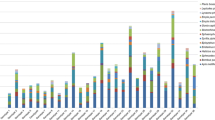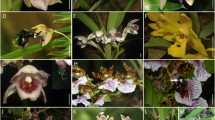Abstract
To better understand the complex pollination biology of Carludovicoideae (Cyclanthaceae), four species from French Guiana were investigated in both the field and laboratory. The pistillate flowers of all species of the subfamily have long staminodes up to 10 cm long or more, which emit scent and apparently attract beetles during anthesis. Scent was collected by standard headspace methods and analyzed in the laboratory by GC/MS. The histology of staminodes, measurements of inflorescence temperatures, and analyses of the floral nutrients were performed. The staminodes have two ducts with a mucilage-like liquid containing sugar, which provides nourishment for beetle visitors. In Evodianthus funifer, four of the six beetle morphospecies (Curculionidae: Acalyptini) were pollinators and oviposited in staminate flowers. The remaining pair of morphospecies were non-pollinators, and avoided entering the inflorescence, while only cutting the staminodes for possible oviposition on the ground. Staminate flowers and staminodes have a high energy content, providing for larval development of the beetles. Our findings revealed that the staminodes released aromatic components, miscellaneous cyclic components, and terpenoids. Some of the major scent compounds of E. funifer and Ludovia lancifolia, i.e., (E,E)-α-farnesene-2(3),9(10)-diepoxid and 3-methylen-2-(pent-2(Z)-enyl)-cyclopentanol, are new to science. Also, Carludovicoideae are a subfamily of plants that attract beetle pollinators through highly specific scent compounds, making them comparable to species of Araceae, Magnoliaceae, and Annonaceae.



Similar content being viewed by others
References
Alonso-Zarazaga MA (2007) Acalyptini C. G. Thomson 1859, correct name for a tribe in Curculioninae (Coleoptera: Curculionidae) and a comment on nomenclatural terminology. Coleopterists' Bull 61:559. https://doi.org/10.1649/0010-065X(2007)61(559:ACGTCN)2.0.CO;2
Anderson RS, Gómez-Pignatorio LD (1997) Systenotelus, a remarkable new genus of weevil (Coleoptera: Curculionidae) associated with Carludovica (Cyclanthaceae) in Costa Rica and Panama. Rev Biol Trop 45:887–904
Beach JH (1982) Beetle pollination of Cyclanthus bipartitus (Cyclanthaceae). Amer J Bot 69:1074–1081
Cardona-Ducke J, Franz NM (2012) Description and phylogeny of a new neotropical genus of Acalyptini (Coleoptera: Curculionidae: Curculioninae) associated with the staminodes of Cyclanthaceae. Zool J Linn Soc 166:559–623. https://doi.org/10.1111/j.1096-3642.2012.00851.x
Dötterl S, David A, Boland W, Silberbauer-Gottsberger I, Gottsberger G (2012) Evidence for behavioral attractiveness of methoxylated aromatics in a dynastid scarab beetle-pollinated Araceae. J Chem Ecol 38:1539–1543. https://doi.org/10.1007/s10866-012-0210-y
Effmert U, Große J, Röse USR, Ehrig F, Kägi R, Piechulla B (2005) Volatile composition, emission pattern, and localization of floral scent emission in Mirabilis jalapa (Nyctaginaceae). Amer J Bot 92:2–12. https://doi.org/10.3732/ajb.92.1.2
Eriksson R (1994a) The remarkable weevil pollination of the neotropical Carludovicoideae (Cyclanthaceae). Pl Syst Evol 189:75–81
Eriksson R (1994b) Phylogeny of the Cyclanthaceae. Pl Syst Evol 190:31–47
Ervik F, Tollsten L, Knudsen JT (1999) Floral scent chemistry and pollination ecology in phytelephantoid palms (Arecaceae). Pl Syst Evol 217:279–297
Franz NM (1999) Biologia reproductiva de algunas Ciclantáceas (Cyclanthaceae) y de los picudos asociados (Coleoptera: Curculionidae). MSc Thesis, Universidad de Costa Rica, San José. https://doi.org/10.1007/s00606-007-0595-1
Franz NM (2003) Mating behaviour of Staminodeus vectoris (Coleoptera: Curculionidae), and the value of systematics in behavioural studies. J Nat Hist 37:1727–1750
Franz NM (2004) Analysing the history of the derelomine flower weevil-Carludovica association (Coleoptera: Curculionidae; Cyclanthaceae). Biol J Linn Soc 81:483–517. https://doi.org/10.1111/j1095-8312.2003.00293.x
Franz NM (2007) Reproductive trade-offs in a specialized plant/pollinator system involving Asplundia uncinata Harling (Cyclanthaceae) and a derelomine flower weevil (Coleoptera: Curculionidae). Pl Syst Evol 269:183–201
Franz NM, Cardona-Ducke J (2013) Description of two new species and phylogenetic reassessment of Perelleschus Wibmer & O’Brien, 1986 (Coleoptera: Curculionidae), with a complete taxonomic concept history of Perelleschus sec. Franz & Cardona-Ducke, 2013. Syst Biodivers 11:209–236. https://doi.org/10.1080/14772000.2013.806371
Franz NM, O’Brien CW (2001) Ganglionus, a new genus of Derelomini (Coleoptera: Curculionidae) associated with Carludovica (Cyclanthaceae). Ann Entomol Soc Amer 94:835–850
Franz NM, Valente RM (2005) Evolutionary trends in derelomine flower weevils (Coleoptera: Curculionidae): from associations to homology. Invertebr Syst 19:499–530. https://doi.org/10.1071/ISO5026
Gonçalves-Souza P, Schlindwein C, Dötterl S, Paiva EAS (2017) Unveiling the osmophores of Philodendron adamantinum (Araceae) as a means to understanding interactions with pollinators. Ann Bot (Oxford) 119:533–543. https://doi.org/10.1093/aob/mcw236
Gottsberger G (1990) Flowers and beetles in the South American tropics. Bot Acta 103:360–365
Gottsberger G (1991) Pollination of some species of the Carludovicoideae, and remarks on the origin and evolution of the Cyclanthaceae. Bot Jahrb Syst 113:221–235
Gottsberger G, Silberbauer-Gottsberger I, Seymour RS, Dötterl S (2012) Pollination ecology of Magnolia ovata may explain the overall large flower size of the genus. Flora 207:107–118. https://doi.org/10.1016/j.flora.2011.11.003
Grimaldi M, Riera B (2001) Geography and climate. In: Bongers F, Charles-Dominique P, Forget P-M, Théry M (eds) Nouragues, dynamics and plant-animal interactions in a neotropical rainforest. Kluwer, Dordrecht, pp 9–18
Harling G (1958) Monograph of the Cyclanthaceae. Acta Horti Berg 18:1–428
Harling G, Wilder GJ, Eriksson R (1998) Cyclanthaceae. In: Kubitzki K (ed) Families and genera of vascular plants. Vol. 3. Flowering plants, monocotyledons: Lilianae (except Orchidaceae), Springer, Berlin, pp 202–215
Knudsen JT, Tollsten L, Ervik F (2001) Flower scent and pollination in selected neotropical palms. Pl Biol 3:642–653
Knudsen JT, Eriksson R, Gershenzon J, Ståhl B (2006) Diversity and distribution of floral scent. Bot Rev 72:1–120
Maia ACD, Dötterl S, Kaiser R, Silberbauer-Gottsberger I, Teichert H, Gibernau M, Navarro DMAF, Schlindwein C, Gottsberger G (2012) The key role of 4-methyl-5-vinylthiazole in the attraction of scarab beetle pollinators: a unique olfactory floral signal shared by Annonaceae and Araceae. J Chem Ecol 38:1072–1080. https://doi.org/10.1007/s10886-012-0173-z
Pereira J, Schlindwein C, Antonini Y, Maia ACD, Dötterl S, Martins C, Navarro DMAF, Oliveira R (2014) Philodendron adamantinum (Araceae) lures its single cyclocephaline scarab pollinator with specific dominant floral scent volatiles. Biol J Linn Soc 111:679–691. https://doi.org/10.1111/bij.12232
Poeppig E, Endlicher S (1838) Nova genera ac species plantarum, vol. 2. Leipzig
Sajo MG, Lombardi JA, Forzza RC, Rudall PJ (2014) Comparative anatomy of reproductive structures in Cyclanthaceae (Pandanales). Int J Pl Sci 175:814–827. https://doi.org/10.1086/676817
Schäffler I, Steiner KE, Haid M, van Berkel SS, Gerlach G, Johnson SD, Wessjohann L, Dötterl S (2015) Diacetin, a reliable cue and private communication channel in a specialized pollination system. Syst Evol 140:95–107. https://doi.org/10.1038/srep12779
Schremmer F (1982) Blühverhalten und Bestäubungsbiologie von Carludovica palmata (Cyclanthaceae) - ein ökologisches Paradoxon. Pl Syst Evol 140:95–107
Schultz K, Kaiser R, Knudsen JT (1999) Cyclanthone and derivatives, new natural products in the flower scent of Cyclanthus bipartitus Poit. Flav Fragr J 14:185–190
Seymour RS (2010) Scaling of heat production by thermogenic flowers: limits to floral size and maximum rate of respiration. Pl Cell Environm 33:1474–1485. https://doi.org/10.1111/j.1365-3040.2010.02190.x
Seymour RS, White CR, Gibernau M (2003) Heat reward for insect pollinators. Nature 426:243–244
Silberbauer-Gottsberger I, Webber AC, Küchmeister H, Gottsberger G (2001) Convergence in beetle-pollinated Central Amazonian Annonaceae, Araceae, Arecaceae, and Cyclanthaceae. In: Gottsberger G, Liede S (eds) Life forms and dynamics in tropical forests. Diss Bot 346:165–183
Teichert H (2008) Pollination biology of cantharophilous and melittophilous Annonaceae and Cyclanthaceae in French Guiana. PhD Thesis, Ulm University, Ulm
Vogel S (1963) Duftdrüsen im Dienste der Bestäubung. Über Bau und Funktion der Osmophoren. Abh Math-Naturwiss Kl Akad Wiss Mainz 10:1–165
Acknowledgements
The field work of Holger Teichert in Les Nouragues was supported by Pierre Charles-Dominique, Philippe Gaucher, and several other French colleagues; his laboratory work in Ulm by Ellen Salzer; and his studies with the cultivated Stelestyles surinamensis by the gardeners of the green houses at the Botanical Garden of Ulm University. Roman Kaiser kindly identified the scent compounds and has given permission to use the results for the present publication. Ilse Silberbauer-Gottsberger suggested many improvements of the manuscript, and Graciela Hintze kindly prepared the photoplates. Two anonymous reviewers and Hugh Morris were extremely helpful with many English and scientific edits, corrections, and suggestions to improve the manuscript.
Author information
Authors and Affiliations
Corresponding author
Ethics declarations
Conflict of interest
The authors declare that they have no conflict of interest.
Additional information
Handling editor: Livia Wanntorp.
Holger Teichert: Former address: Institut für Systematische Botanik und Ökologie, Albert Einstein Allee, Universität Ulm, 89081 Ulm, Germany.
Rights and permissions
About this article
Cite this article
Teichert, H., Dötterl, S. & Gottsberger, G. Scent emissions and floral nutrients of Carludovicoideae (Cyclanthaceae) and their importance for associated beetles. Plant Syst Evol 304, 831–839 (2018). https://doi.org/10.1007/s00606-018-1513-4
Received:
Accepted:
Published:
Issue Date:
DOI: https://doi.org/10.1007/s00606-018-1513-4




